AMANDAHICKMAN
Premium Study Guides & Exam Prep for 2024/2025: Ace Your Courses
- 1612
- 0
- 156
Community
- Seguidores
- Siguiendo
220 Comentarios recibidos
1768 artículos
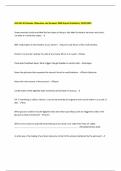
ASU BIO 181 Module 12Question and Answers With Expert Solutions| 2024/2025
Draw concentric circles and label the four layers of the gut. Also label the hole at the inner most circle. List what is in these four layers. - 90% of absorption in the intestine occurs where? - Jejunum and illeum of the small intestine. Vitamin K cannot be made by the cells of your body. Where is it made? - Colon
- Examen
- • 2 páginas •
Draw concentric circles and label the four layers of the gut. Also label the hole at the inner most circle. List what is in these four layers. - 90% of absorption in the intestine occurs where? - Jejunum and illeum of the small intestine. Vitamin K cannot be made by the cells of your body. Where is it made? - Colon
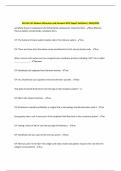
ASU BIO 181 Module 10Question and Answers With Expert Solutions| 2024/2025
Lymphatic tissue is composed of the following five components. Please list them. - Bone Marrow, Thymus, Spleen, Lymph Nodes, Lymphatic Ducts T/F: The humoral immune system involves cells in the immune system. - True T/F: There are times when the spleen can be considered to be the primary lymph node. - True When immune cells mature and can recognize trans-membrane proteins indicating "self", this is called ______________. - Tolerance T/F: Red blood cells originate from the bone marrow...
- Examen
- • 2 páginas •
Lymphatic tissue is composed of the following five components. Please list them. - Bone Marrow, Thymus, Spleen, Lymph Nodes, Lymphatic Ducts T/F: The humoral immune system involves cells in the immune system. - True T/F: There are times when the spleen can be considered to be the primary lymph node. - True When immune cells mature and can recognize trans-membrane proteins indicating "self", this is called ______________. - Tolerance T/F: Red blood cells originate from the bone marrow...
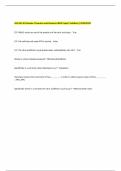
ASU BIO 181 Module 9 Question and Answers With Expert Solutions| 2024/2025
T/F: FADH2 results as one of the products of the citric acid cycle. - True T/F: The cell does not need ATP to survive. - False T/F: The citric acid/Kreb's cycle breaks down carbohydrates into CO2. - True Where is carbon dioxide produced? - Mitochondrial Matrix
- Examen
- • 1 páginas •
T/F: FADH2 results as one of the products of the citric acid cycle. - True T/F: The cell does not need ATP to survive. - False T/F: The citric acid/Kreb's cycle breaks down carbohydrates into CO2. - True Where is carbon dioxide produced? - Mitochondrial Matrix
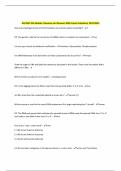
ASU BIO 181 Module 7Question and Answers With Expert Solutions| 2024/2025
How many hydrogen bonds are there between an A and its paired nucleotide? - 2 T/F: The genetic code for the conversion of mRNA codons to proteins has redundancy - True List one type of post-translational modification - Proteolysis, Glycosylation, Phosphorylation. For DNA Polymerase III to work which of these components has to act first? - Primase Draw the sugar in DNA and label the carbons as discussed in the lecture.
- Examen
- • 3 páginas •
How many hydrogen bonds are there between an A and its paired nucleotide? - 2 T/F: The genetic code for the conversion of mRNA codons to proteins has redundancy - True List one type of post-translational modification - Proteolysis, Glycosylation, Phosphorylation. For DNA Polymerase III to work which of these components has to act first? - Primase Draw the sugar in DNA and label the carbons as discussed in the lecture.
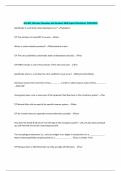
Specifically in a cell where does Glycolysis occur? - Cytoplasm T/F The cell does not need ATP to survive. - False Where is carbon dioxide produced? - Mitochondrial matrix T/F The citric acid/Kreb's cycle breaks down carbohydrates into CO2. - True
Specifically in a cell where does Glycolysis occur? - Cytoplasm T/F The cell does not need ATP to survive. - False Where is carbon dioxide produced? - Mitochondrial matrix T/F The citric acid/Kreb's cycle breaks down carbohydrates into CO2. - True T/F FADH2 results as one of the products of the citric acid cycle. - True Specifically where in a cell does the citric acid/Kreb's cycle occur? - Mitochondrial Matrix
- Examen
- • 8 páginas •
Specifically in a cell where does Glycolysis occur? - Cytoplasm T/F The cell does not need ATP to survive. - False Where is carbon dioxide produced? - Mitochondrial matrix T/F The citric acid/Kreb's cycle breaks down carbohydrates into CO2. - True T/F FADH2 results as one of the products of the citric acid cycle. - True Specifically where in a cell does the citric acid/Kreb's cycle occur? - Mitochondrial Matrix
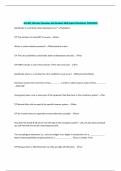
ASU BIO 181 Exam 2Question and Answers With Expert Solutions| 2024/2025
Specifically in a cell where does Glycolysis occur? - Cytoplasm T/F The cell does not need ATP to survive. - False Where is carbon dioxide produced? - Mitochondrial matrix T/F The citric acid/Kreb's cycle breaks down carbohydrates into CO2. - True T/F FADH2 results as one of the products of the citric acid cycle. - True Specifically where in a cell does the citric acid/Kreb's cycle occur? - Mitochondrial Matrix Glycolysis requires the investment of two_________ in order to obtain a g...
- Examen
- • 8 páginas •
Specifically in a cell where does Glycolysis occur? - Cytoplasm T/F The cell does not need ATP to survive. - False Where is carbon dioxide produced? - Mitochondrial matrix T/F The citric acid/Kreb's cycle breaks down carbohydrates into CO2. - True T/F FADH2 results as one of the products of the citric acid cycle. - True Specifically where in a cell does the citric acid/Kreb's cycle occur? - Mitochondrial Matrix Glycolysis requires the investment of two_________ in order to obtain a g...
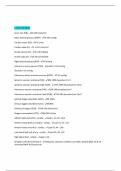
CCRN Exam REVIEW questions and Answers | 100% Score ( 2024-2025)
Heart rate (HR) - 60-100 beats/min Mean arterial pressure (MAP) - 70-105 mmHg Cardiac output (CO) - 4-5 L/min Cardiac index (CI) - 2.5-4.5 L/min/m2 Stroke volume (SV) - 50-100 ml/beat Stroke index (SI) - 35-60 ml/m2/beat Right arterial pressure (RAP) - 4-8 mmHg Pulmonary artery pressure (PAP) - Systolic 15-30 mmHg Diastolic 5-15 mmHg Pulmonary artery occlusive pressure (PAOP) - 8-12 mmHg Systemic vascular resistance (SVR) - 800-1200 dynes/sec/cm-5 Systemic vascular resistance index (S...
- Examen
- • 7 páginas •
Heart rate (HR) - 60-100 beats/min Mean arterial pressure (MAP) - 70-105 mmHg Cardiac output (CO) - 4-5 L/min Cardiac index (CI) - 2.5-4.5 L/min/m2 Stroke volume (SV) - 50-100 ml/beat Stroke index (SI) - 35-60 ml/m2/beat Right arterial pressure (RAP) - 4-8 mmHg Pulmonary artery pressure (PAP) - Systolic 15-30 mmHg Diastolic 5-15 mmHg Pulmonary artery occlusive pressure (PAOP) - 8-12 mmHg Systemic vascular resistance (SVR) - 800-1200 dynes/sec/cm-5 Systemic vascular resistance index (S...
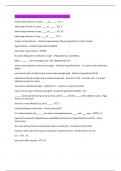
Pool Operator Exam Expert Verified 20242025
Pool Operator Exam Expert Verified 20242025
- Examen
- • 6 páginas •
Pool Operator Exam Expert Verified 20242025
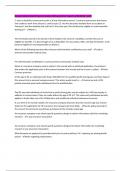
Nevada Life and Health Exam Simulator (200 questions) Expert verified2024 2025
Nevada Life and Health Exam Simulator (200 questions) Expert verified2024 2025
- Examen
- • 12 páginas •
Nevada Life and Health Exam Simulator (200 questions) Expert verified2024 2025

Nevada Life & Health Insurance Questions and Answers |Expert Verified 20242025
Nevada Life & Health Insurance Questions and Answers |Expert Verified 20242025
- Examen
- • 18 páginas •
Nevada Life & Health Insurance Questions and Answers |Expert Verified 20242025

2023 AQA AS BUSINESS 7131/2 Paper 2 Business 2 Question Paper & Mark scheme (Merged) June 2023 [VERIFIED]
2023 AQA AS BIOLOGY 7401/2 Paper 2 Question Paper & Mark scheme (Merged) June 2023 [VERIFIED]
2023 AQA GCSE PSYCHOLOGY 8182/2 Paper 2 Social Context and Behaviour Question Paper & Mark scheme (Merged) June 2023 [VERIFIED]
2023 AQA GCSE RELIGIOUS STUDIES B 8063/1 Paper 1 Catholic Christianity Question Paper & Mark scheme (Merged) June 2023 [VERIFIED]
2023 AQA GCSE RELIGIOUS STUDIES B 8063/1 Paper 1 Catholic Christianity Question Paper & Mark scheme (Merged) June 2023 [VERIFIED]